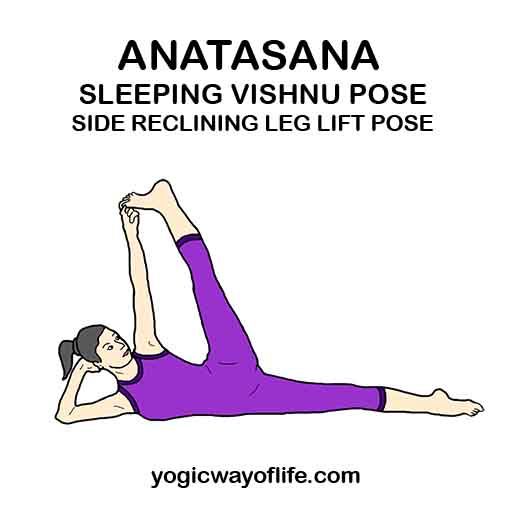Anantasana, the Sleeping Vishnu Pose or the side reclining leg lift posture, is so called as it resembles the Lord Vishnu sleeping on the thousand headed serpent Ananta. In Sanskrit, Ananta means infinite and Asana is a pose.
Anantasana improves flexibility of your legs and hips. It stretches the hamstrings, strengthens the hips and improves the functioning of digestive organs.

How to do Anantasana (The Sleeping Vishnu Pose)?
- Lie down on the mat in Shavasana with hands and legs extended and relaxed.
- Gently turn over to the right. Keep the head raised above the ground. Support the head with your right hand, with the head gently resting on the right palm. The right elbow is placed firmly on the ground to support the weight of the head.
- Raise the leg upwards without bending. Try to bring it to a 90 degrees angle to the ground. It will need some flexibility to achieve this. Beginners can start with smaller angles and then slowly, over a period of time increase it to 90 degrees.
- Hold the toe (or the feet) of the left leg with your left hands.
- This is the final position. Look straight ahead and maintain the position for as long as you are comfortable. Breathe normally during in the final position.
- To release the pose, release your grip on the left toes/feet and bring down the left leg to the floor. Turn over and lie flat on the floor in Shavasana or the corpse pose.
- One can repeat the process with the right leg raised also if desired.
Benefits of this pose range from improved strength and flexibility to better digestion.
Benefits of Anantasana (The Sleeping Vishnu Pose)
- Anantasana improves flexibility of the Hips.
- It gives a good stretch to the Hamstrings and the inner side leg muscles.
- Anantasana massages the abdomen and internal organs.
- It improves digestion.
- It improves the flexibility and strength of the torso.
Contraindication for Anantasana
- Avoid Anantasana if you have any disk prolapse in the lower spine.
- If you had any recent surgeries or injury of the spine or hips, then do not attempt this posture.
- This is an intermediate level posture. Do not strain while raising the leg. Over a period of time, when the hamstring and the inner-side leg muscles become flexible, one can achieve the 90-degree angle as desired.
